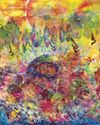
Some years ago, I started a course of meditation. Although ‘mindfulness’ was in the air and meditation programmes were being offered in almost every other institution, I knew virtually nothing about meditation or mindfulness or the Buddhist traditions from which they came. ‘Mindfulness’ seemed obviously a good thing, for it was the opposite of mindlessness. Who could oppose that? But what exactly did it mean? How had it become so widely esteemed across so many institutions in the West? And what was happening to Buddhism itself as it entered our highly eclectic postmodern Western culture?
My Buddhist course was practical. It was about physical posture and following the breath in various ways. As my speculative questions remained unanswered they became more restless – until I decided to embark on my own journey. Being a poet and teacher of literature, my instinctive first move was to take a fresh look at T.S. Eliot’s The Waste Land, for I remembered that this iconoclastic poem famously ended in Sanskrit. But it was soon to become a much more complicated quest, forcing me to go further back in time, to make unexpected connections and to see entirely new constellations. I had to discover the importance of the philosopher Schopenhauer, the febrile influence of Madam Blavatsky, the power of Zen especially during the 60s, the charisma of the Dalai Lama, and finally, enter the modern world of neurology and contemporary therapy. I discovered that in the West, meditation and mindfulness not only had a history many people were unaware of, but that as Buddhism adapted to the culture of the West its identity was changing. Without gods or a supernatural realm, it was fast becoming a form of philosophical humanism, committed to personal well-being and living the good life.
Bu hikaye Philosophy Now dergisinin June/July 2020 sayısından alınmıştır.
Start your 7-day Magzter GOLD free trial to access thousands of curated premium stories, and 9,000+ magazines and newspapers.
Already a subscriber ? Giriş Yap
Bu hikaye Philosophy Now dergisinin June/July 2020 sayısından alınmıştır.
Start your 7-day Magzter GOLD free trial to access thousands of curated premium stories, and 9,000+ magazines and newspapers.
Already a subscriber? Giriş Yap

Metaphors & Creativity
Ignacio Gonzalez-Martinez has a flash of inspiration about the role metaphors play in creative thought.

Medieval Islam & the Nature of God
Musa Mumtaz meditates on two maverick medieval Muslim metaphysicians.

Robert Stern
talks with AmirAli Maleki about philosophy in general, and Kant and Hegel in particular.

Volney (1757-1820)
John P. Irish travels the path of a revolutionary mind.

IT'S A WONDERFUL LIFE
Becky Lee Meadows considers questions of guilt, innocence, and despair in this classic Christmas movie.

"I refute it thus"
Raymond Tallis kicks immaterialism into touch.

Cave Girl Principles
Larry Chan takes us back to the dawn of thought.

A God of Limited Power
Philip Goff grasps hold of the problem of evil and comes up with a novel solution.

A Critique of Pure Atheism
Andrew Likoudis questions the basis of some popular atheist arguments.

Exploring Atheism
Amrit Pathak gives us a run-down of the foundations of modern atheism.